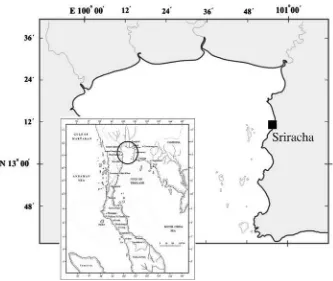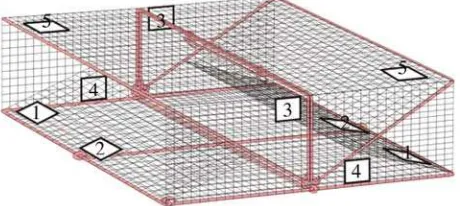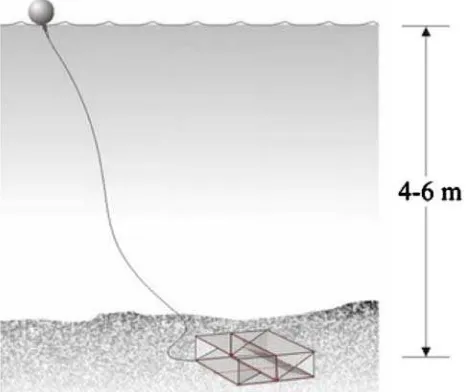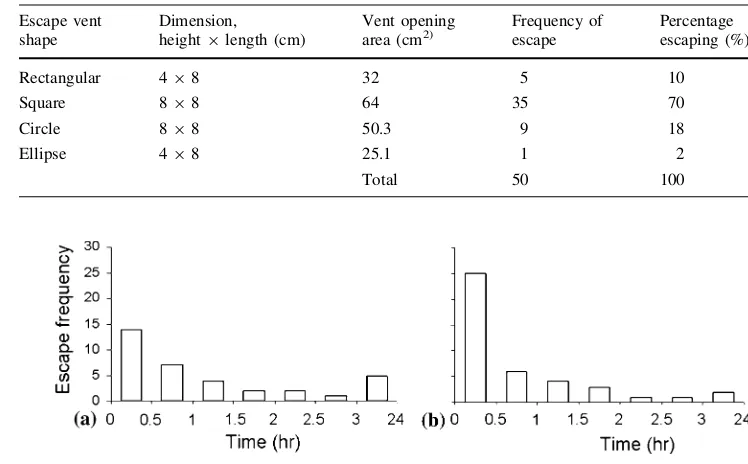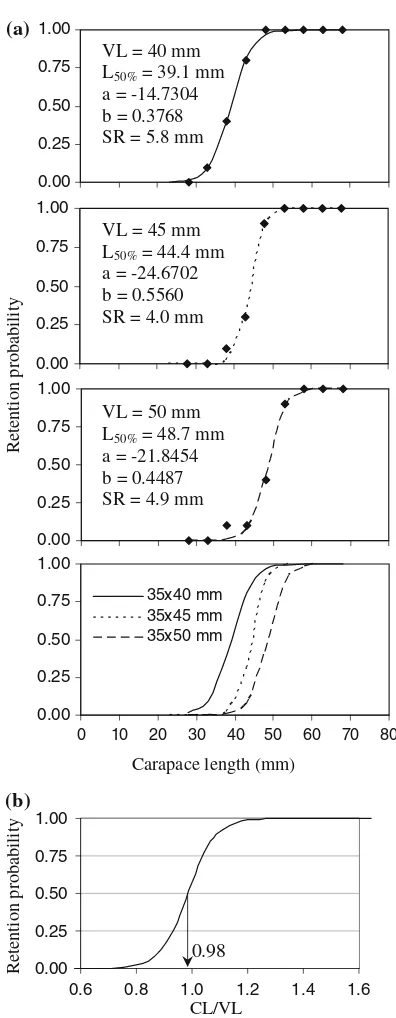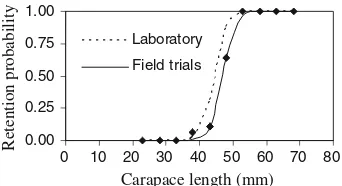O R I G I N A L A R T I C L E Fisheries
Use of escape vents to improve size and species selectivity
of collapsible pot for blue swimming crab
Portunus pelagicus
in Thailand
Anukorn BoutsonÆChaichan MahasawasdeÆ Songsri MahasawasdeÆ Suriyan TunkijjanukijÆ Takafumi Arimoto
Received: 1 May 2008 / Accepted: 11 August 2008 / Published online: 10 December 2008 ÓThe Japanese Society of Fisheries Science 2008
Abstract Laboratory experiments were firstly conducted to determine the possibility of modification of the col-lapsible pot for blue swimming crabPortunus pelagicusby designing appropriate escape vents in terms of shape, position, and size to improve size selectivity by reducing the catch of immature crabs. In laboratory observations, nearly square-shaped vents of 35 mm height and 45 mm length, located at the lower part of the side panel, showed the best performance to allow the escape of immature-size crabs by side-crawling escape behavior through the vents, withL50%selection carapace length (CL) of 39.1, 44.4, and
48.7 mm CL for 40, 45, and 50 mm vent length, respec-tively. Comparative fishing trials between conventional and vented pots with vents of 35945 mm size were con-ducted to examine the crab size and species selectivity. Use of the vented pots was found to reduce the number of immature crabs in the catch from 70.5% to 11.0% on average, while not affecting the catch efficiency of mature-size crabs. The vented pots also had a selective effect for reducing the catch of bycatch species in comparative fishing trials.
Keywords Blue swimming crabBycatchDiscard
Escape ventPortunus pelagicusPotSize selectivity
Species selectivity
Introduction
Blue swimming crab Portunus pelagicus is an important coastal species in Thailand both for the domestic and export markets, with an annual production of around 40,000 tons [1], worth about US $50 million. Collapsible pot (Fig.1) is a major fishing gear type together with the bottom gillnet for catching the crab. After introduction of the pot from Japan in 1981 [1,2], intensive fishing activ-ities by small-scale operations using 200–300 pots per setting operation, and commercial longline-type boats set-ting 2,000–5,000 or more pots, have resulted in a decrease of catch per unit effort, and increased catch of smaller-size blue swimming crab [3]. This trend requires urgent miti-gation measures for resource conservation together with renovation of the coastal environment. However, no prac-tically successful measures have so far been reported for resource management and stock enhancement.
In the crab pot fishery in Thailand, a large proportion of the catch consists of immature crabs and nontarget species including other shellfish and finfish, which have to be discarded onboard after hauling if the species are of no or low economic importance. Boutson et al. [4] reported that 32–42% of the blue swimming crab catch was immature based on onboard monitoring. The discard ratio [5] by number for the crab was counted as 2.21 among all catch species, which means that 2.21 animals are discarded for every one commercially taken crab. In order to reduce the catch of undersized target species, bycatch, and discards in pot fishing, escape windows or vents and other methods have been demonstrated and employed for lobster traps [6–10] and crab pots [6, 11–23]. It is envisaged that adoption of escape vents in pots for the crab can allow the escape of immature-sized crabs, and furthermore reduce the proportion of other species and thus minimize discards. A. BoutsonT. Arimoto (&)
Graduate Course of Applied Marine Biosciences, Tokyo University of Marine Science and Technology, Tokyo 108-8477, Japan
e-mail: tarimoto@kaiyodai.ac.jp
C. MahasawasdeS. MahasawasdeS. Tunkijjanukij Department of Marine Sciences, Kasetsart University, Bangkok 10900, Thailand
There are other approaches aimed to reduce the catch of undersized crabs from pots, such as installing escape panels [11, 12, 15, 19], increasing mesh size [13, 16, 17, 22], modifying mesh shape [18,19], and adjusting pot shape or entrance design [16,21–23]. Pot design should be decided according to the target species [6]. However, in Thailand, the box-shaped collapsible pot is the most popular type used in coastal waters, despite the fact that the box-shaped pot is not the best design for swimming crabs when com-pared with the greater selectivity of conical- or dome-shaped pots [22,23]. The reason for this unique situation in Thailand can be explained through the good catch rate, low pot cost, and high portability that allows a large number to be loaded onto a small deck space. Considering the pos-sible acceptance and willingness of Thai pot fishers, the simplest modification of the conventional box-shaped pots with the minimum cost is installation of escape vents. This
can also function as a possible solution for the effects of ghost fishing [24,25], which was estimated in Australia for P. pelagicus to continue the catch for more than 4 years after being lost at sea [26]. The reduction of undersized crabs and bycatch species by use of vents is potentially an effective management tool for this fishery.
In this study, laboratory experiments were firstly con-ducted to determine the possibility of modifying the collapsible pot by designing escape vents to improve size selectivity, focused on reducing the catch of immature blue swimming crabs. Comparative fishing trials were also conducted between conventional and modified pots with escape vents to assess crab size selectivity and composition of nontarget species.
Materials and methods
Laboratory experiments were conducted at Sriracha Fish-eries Research Station, Kasetsart University, Chonburi Province, Thailand, during February to May 2004. The shape, position, and size of escape vents were investigated to determine the most appropriate vent design and selec-tivity performance for reducing the catch of immature-size crabs. Comparative fishing trials were conducted with two fishing operations in May 2005 in the coastal waters adjacent to the research station (Fig. 2) to compare catch composition between conventional and vented pots in terms of crab size and species selectivity.
Fig. 2 Location map of the study area (filled square)
Experimental pot
Collapsible pots were obtained from local fisherman. The pot is box shaped, with dimensions of 36954919 cm, having two slit entrances (Fig.1) and a galvanized rod frame (4 mm diameter), and being covered with green polyethylene square-shaped mesh net of 38 mm mesh size. An iron hook is attached at the top panel for pot setup and collapsible function.
Laboratory experiments
Outdoor experimental tanks measuring 1.791.791 m3 with plastic shading cover were used. Filtered and aerated seawater of 28–30°C was supplied to the tanks with 30 cm of seawater level, to cover the pot height of 19 cm.
A total of approximately 300 blue swimming crabs were collected by pot fishing in the coastal waters adjacent to the research station and kept in a stock tank for 3–5 days before the experiments. The crabs were measured for car-apace length (CL) as defined by distance between frontal and intestinal margins of the carapace; a size range of 26– 70 mm was obtained. Carapace height (CH) was also measured to obtain its relationship with CL.
Appropriate design of escape vents was examined by comparing different vent shapes of square, rectangle, cir-cle, and ellipse. All vent shapes had the same length of 80 mm, with different height for the rectangular and ellipse vents of 40 mm (Fig.3a). The vent frame was made from 2-mm-diameter wire, and located at the bottom sides of the lower slope panel in the same pot as shown in Fig.3b. All the shapes were sufficiently large to allow all of the crabs to escape through the vent openings. One to three crabs were placed inside the pot, and the time required prior to escape in daytime through each vent shape was recorded
for up to 50 escapes in total. New individuals were intro-duced to the pots to maintain the number of crabs inside after the escape of an individual. If a previously escaped crab was used for a second time, in order to avoid any recognition and selection of the escape vent position, the direction of the pot was changed by turning the pot. Crabs which did not escape during a 24-h period were replaced with new ones.
After assessing the most appropriate vent shape, the vent positions were examined by comparing five different locations in the pot: at the corner and center parts of the lower slope panel, at the upper and lower parts of the side panel, and at the corner of the top panel, as shown in Fig.4. The vents were located on both sides at the same position in the same pot in order to monitor the escape behavior according to the time recorded for each escape from each vent position. Each individual crab was used only once in this experiment. The time recording was also done for every escape from each vent position for up to 50 escapes in total.
Square 8 cm
Circle
(r = 4 cm) 8 cm
4 cm Ellips
4 cm height Rectangular
8 cm length
(a) (b)
Fig. 3 Four different shapes of escape vent (a), located at the bottom sides of the lower slope panel (b) used to observe the escape behavior of blue swimming crabs from the pot
As the last phase of the laboratory experiment, size selectivity performance of the escape vents was examined by placing crabs of known size groups in the pot in order to obtain precise size selection data [6], for vent sizes of 40, 45, and 50 mm in length and fixed height of 35 mm. Each size of vent was located at the bottom of the side panel according to the results of the vent position experiment. The crabs were grouped according to 5 mm CL classes for a range of 26–70 mm by placing ten crabs of each size class range in the pot. Each vented pot was monitored in the experimental tank for 24 h to measure the number of crabs escaping and remaining inside. Here, the aim was to determine the appropriate vent size to allow the escape of immature female blue swimming crabs (CL\46 mm)
[27]. The SELECT model [28,29] was used to assess each escape vent selection by considering the selection range (L75%–L25%) and 50% selection length (L50%) [28–32]. The
logistic selectivity curves were estimated using Microsoft Excel with solver to specify the two parameters,aandb, in the equation:
S lð Þ ¼expðaþblÞ=½1þexpðaþblÞ:
The selectivity curves of the three vent sizes were estimated and the master curve [32] according to CL and vent length was determined.
Field experiments
The appropriate vent design in terms of shape, location, and dimension from the laboratory experiments was tested in fishing trials on 4 and 5 May 2005 in the shallow waters adjacent to the Sriracha Research Station, Faculty of Fisheries, Kasetsart University, in the upper Gulf of Thailand (Fig.2) as a fishing ground for small-scale crab pot fishermen, about 1–1.5 km from shore with depth of 4– 6 m, and substratum composed of muddy sand. Two escape vents of 35945 mm were located at opposite sides of the pot, as shown in Fig.5, to compare with the conventional type of pot. Fifty pots of each type were used and all pots were deployed individually, connected to a 10–12 m length of polypropylene rope and marked with a buoy (Fig.6). They were baited with approximately the same sized fresh trevally,Selaroides leptolepis, pierced and bound by wire at the center bottom of the pots. Both types of pot were dropped together as a pair in each deployed position at intervals of 20–25 m, with 1 day soaking time, following the normal operating procedure of small-scale crab pot fishermen. Pots were retrieved and catch species and size of individuals from each pot recorded.
The selection curve for the pot with 35945 mm vent in fishing trials was analyzed and compared with that of the laboratory experiment results, under the assumption for fishing trial data that the catch numbers in each length class
(5 mm intervals, 20–70 mm CL) in conventional pot were the number of crabs that could escape from the vented pot; all catch numbers of larger size ([50 mm CL) from both
types of pot were retained for the comparison analysis.
Results
Laboratory experiments
Escape vents allowed smaller blue swimming crabs to escape with different frequencies for the different vent shapes, positions, and sizes. Comparison of the escape frequency among differently shaped vents (Table1) showed the highest rate of escape (70%) with the square-shaped vent, followed by the circle (18%), rectangle (10%), and ellipse. The square-shaped vent showed the highest escape frequency, even though the same vent length (VL) of 80 mm, which would allow all crab sizes to escape freely, was used for all vent shapes. Vent opening area may Fig. 5 Escape vents (35945 mm) were located at both sides of the bottom at the side panel for the field fishing trials
be the decisive factor for enhancing crab escape, with the square superior to the circle, and the rectangular superior to the eclipse, even with almost the same opening area. Figure7a shows the escape frequency from the square-shaped vent against elapsed time, with 14 individuals escaping in the first 30 min of the experiment.
Table2 shows the escape frequency results for square vents among the different positions, which indicates that the best vent position was at the bottom of the side panel, through which 84% of crabs escaped, followed by the corner position of the slope panel. Among the total number of escapes of 42 individuals from the lower side vent, 25 crabs escaped within the first 30 min, as shown in Fig.7b. No individuals escaped from the top panel and the upper part of the side panel, which can be explained by the search behavior of crabs of crawling on the bottom panel.
According to observations of escape behavior, CL was related to VL, and CH was related to vent height, due to the side crawling behavior of the crabs when escaping through the vents. Crabs with CL and CH just fitting through the dimension VL struggling most to push their body through
the vent, while smaller crabs in most cases could escape smoothly through the vent. Size selectivity according to the different escape VLs are shown as selectivity curves in Fig.8a, giving the probability of retained numbers among ten individuals put in the pot for each CL class; the patterns are similar, shifting to the right as VL increases. Two further parameters are shown in Fig.8: the selection range (SR) and the 50% selection length (L50%), which are used
to compare selection curves [28–30]. SR is determined by the slope of the curve and gives an indication of the size range selection that occurs; e.g., if all crabs below 30 mm CL escaped and all above 50 mm CL are retained, the SR will be 20 mm. L50%is an indication of the CL class for
which half of all crabs escape. The SR for VLs of 40, 45, and 50 mm were estimated (L75%–L25%) to be 5.8, 4.0, and
4.9 mm, and theL50%for VLs of 40, 45, and 50 mm were
39.1, 44.4, and 48.7 mm CL, respectively. The L50% for
50 mm VL was closest to the first maturity crab size ([46 mm CL), while the SR of the 45-mm vent was
smaller than that of the 50-mm vent and slightly smaller than that of the 40-mm vent. According to the similar pattern of selectivity curves for the different VL values, a master curve was calculated for the ratio of CL/VL as shown in Fig.8b; the 50% retention probability occurred at a CL-to-VL ration of 0.98, close to 1.00, which supports the precise selectivity function of the rigid vent frame to the hard body structure of the blue swimming crab.
The CL of mature female crabs in relation to CH is larger than that for males [3, 27]. The size relation for female crab is CH=0.46CL?3.8 (R2=0.91,n =100). Though the best positive result for the vent shape was square, after considering the relationship of crab size (CH and CL) to vent size, we decided to set the vent design with Table 1 Frequency comparison
of the crabs that escaped through the differently shaped escape vents
Escape vent shape
Dimension,
height9length (cm)
Vent opening area (cm2)
Frequency of escape
Percentage escaping (%)
Rectangular 498 32 5 10
Square 898 64 35 70
Circle 898 50.3 9 18
Ellipse 498 25.1 1 2
Total 50 100
Fig. 7 Frequency of escape through the square vent (a) in the shape experiment, and lower side panel vent (b) in the vent position experiment
Table 2 Frequency comparison of crabs that escaped through the square vent at different positions
No. Position of escape vents
Frequency of escape
Percentage escaping (%)
1 Corner slope panel 7 14
2 Center slope panel 1 2
3 Upper side panel 0 0
4 Lower side panel 42 84
5 Corner top panel 0 0
nearly square shape of 35 mm height with 45 mm length, as shown in Fig.5, as this allows practical as well as functional usage of the pots.
Field experiments
Based on the comparative fishing trials, the catch com-parison for blue swimming crab between conventional and
vented pots is shown in Table3. The vented pots reduced the number of immature crabs caught from 61% to 14.3% on 4 May 2005 and from 80% to 7.7% on 5 May 2005. From the catch pooled over both days, conventional pot caught 45 immature and 21 mature crabs, while vented pot caught 3 immature and 24 mature crabs. Those results show that the vented pot can reduce the number of immature size crabs caught while not reducing the catch efficiency for mature size crabs.
The crab size (CL) from each pot type in comparative fishing is shown in Fig.9. The vented pots showed a posi-tive result, clearly excluding the small-size crabs while retaining the larger size when compared with the conven-tional pot. Crab size caught by vented pots was significantly larger than the size caught by conventional pots (Mann– WhitneyUtest;Z= 4.27,p\0.01). Size selectivity of the
35945 mm vent for the crabs from fishing trails was analyzed and is shown in Fig.10as a comparison with the laboratory results. The selectivity curve from the trails shifts to the right withL50%of 46.9 mm, and SR of 4.0 mm
as in the laboratory. The two estimated selectivity curves are not the same, with a lower probability of retention of larger CL crabs for the field trial selectivity, possibly due to difference in the number of crabs in each length class between laboratory and field conditions, particularly for the crabs with CL of 35–45 mm, which is the dominant size in the shallow fishing grounds used in the field trials. Carapace length (mm)
Fig. 8 aSize selectivity for blue swimming crab according to escape vent length when vent height was fixed at 35 mm,bmaster curve for crab size (CL) according to vent length (VL)
Table 3 Size comparison of blue swimming crab catch between conventional and vented pots on 4 and 5 May 2005
Conventional pot Vented pot Total
Mature Immature Mature Immature
4 May 5 20 12 1 38
5 May 16 25 12 2 55
Total 21 45 24 3 93
Fig. 9 Blue swimming crab size sampled with conventional pots
Overall catch composition of crabs and other bycatch species for each pot type shows differences in numbers, catch composition, average size, range (min.–max.), and standard deviation (Table4). Regarding bycatch compo-sition by number of individuals, Table4 shows that the vented pots mainly caught fewer than conventional pots. This demonstrates the positive selective function of vents on the amount of bycatch, while no significant differences in terms of length for each species caught in the two types of pot were observed (ANOVA,p =0.05), except for the case of blue swimming crab. In the vented pot, none or less catch of some accidentally caught species were listed, such as smooth-shelled crab, red crab, striped catfish, cardinal fish, gastropod, and sea urchin.
Discussion
Pots are known to be highly selective for both species and sizes, due to their capture function as a passive gear using
bait for attraction, as well as the entrance design with a nonreturn device. Exclusion of small organisms can be controlled by adding an escape opening [11,12, 15, 19]. Selection performance can be established by gear design in terms of the size, shape, location, and construction material of the escape vents, particularly for crabs and lobsters which have rigid shells. Size selectivity of an escape opening can be quite precisely assessed by selectivity experiments conducted by placing crabs of a known size in pots with escape openings [6]. The rigid exoskeleton and dexterity of decapods to orient themselves to the most advantageous position for escape can account for this precision in selectivity. The escape vent, however, only works when the captured animal can find the opening, so that more than one vent is usually recommended [11, 12, 19, 20]. Stasko [7] suggested a general rule based on observations that Cancer irroratus and Homarus americ-anus oriented themselves such that the smallest opening through which an animal could be pushed by hand was also the smallest opening it would pass through unaided.
Laboratory experiments to determine suitable escape vent to facilitate immature blue swimming crabs to escape revealed that the shape, position, and size of the vents affected the crab escape frequency from the pots, similar to the results of Nulk [8] and Brown [12]. Square-shaped vents located at the bottom of the side panel were superior. Since the water in the experimental tank was clear under high ambient light levels in daytime, the crabs could preferably select the vent through which to escape with the largest opening area as the square shape, followed by the circle shape. The bottom of the side panel was the best position for the crabs to escape, which is strongly related to the behavioral characteristics of the crabs while confined
Retention probability
Carapace length (mm) 0.00
0.25 0.50 0.75 1.00
0 10 20 30 40 50 60 70 80
Laboratory
Field trials
Fig. 10 Size selectivity of 35945 mm escape vent for blue swimming crab from the field trials with L50%=46.9 mm, a=
-25.9403, b=0.5528, and SR=4.0 mm, in comparison with the result from the laboratory observation
Table 4 Catch composition comparison between conventional and vented pots, based on the two comparative fishing trials
Common name Scientific name Number of catch Length size (mm)
Conventional pot
Vented pot
Conventional pot Vented pot
Mean Range (SD) Mean Range (SD)
1. Blue swimming craba Portunus pelagicus 66 27 43.9 21–70 (±10.5) 53.1 39–63 (±5.8)
2. Chinese filefisha Monacanthus
chinensis
33 24 77.1 34–113 (±18.5) 78.5 48–135 (±20.3)
3. Ridged swimming craba Charybdis natator 14 2 35.0 24–51 (±7.0) 39.5 33–46
4. Spiral melongenaa Pugilina cochlidium 10 13 65.3 58–84 (±7.2) 56.9 40–79 (±12.45) 5. Mangrove stone craba Myomenippe
hardwickii
6 2 47.3 37–63 49.0 48–50
6. Toad fish Batrachus grunniens 5 4 161.6 115–227 171.7 152–155
7. Others (crabs, fish,a gastropod, cuttlefisha)
8 2
Total 142 74
inside the narrow space of the pot. From direct observa-tions in the tank, crabs usually remained in the bottom corner of pots unless absolutely necessary, for example, foraging, avoiding attacks by larger crabs, or trying to escape. They mainly move by side crawling around the corner area of the bottom pot panel. This behavior provides the crabs with frequent opportunities to find vents that are located at the bottom of the side panel.
Laboratory observations revealed that the crabs escaped from vents by side crawling behavior, hence CL is related to VL, and CH to the vent height. Brown [12] also reported that escape-gap selection depends upon body length and depth rather than carapace width. Though the best vent shape was the square type in the laboratory experiment, it was not proportional to the crab body shape. The vent height was fixed at 35 mm, which was large enough for all immature crabs to escape. The square-shaped vent provides unnecessary space that can affect selectivity for crabs and other bycatch species; consequently a nearly square shape of 35 mm in height and 45 mm in length, which is more appropriate for crab shape as confirmed in size selectivity experiments, was used (Fig.8).
Eldridge et al. [11]. reported a self-culling pot where 2.5-inch-diameter escape ports, two in the top and one in the bottom, gave the best results to reduce sub-legal-sized blue crabs, Callinectes sapidus, according to laboratory observations and field trials. They did not compare the escape position between top and bottom, while our labo-ratory observations confirmed that P. pelagicus rarely crawls up to the top panel. They also reported that the circular shape was superior to the rectangular one, due to the larger opening area in a circular shape.
The appropriate escape vent size was determined by CL instead of CW as a parameter for the selectivity curves due to the side crawling behaviour. Regarding the size selec-tivity in Fig.8, based on the three different sizes of escape vents (40, 45, and 50 mm in length935 mm in fixed height), VL of 50 mm is the most suitable to release immature size crab because itsL50%of 48.7 mm is close to
the size of sexual maturity ([46 mm CL) to ensure a
chance to reproduce at least once before being captured. This vent size of 50 mm length, however, can create a greater possibility of economic loss, particularly for small-scale fishermen who operate in inshore areas and catch large amounts of small-sized crabs [4], which all have a marketable value even though with a low unit price. Hence, a vent size of 35945 mm was employed in the field trials, based on consideration of the L50% value, which was
closest to the mature crab size of 44.4 mm, and also its smallest SR of 4.0 mm.
Various parameters can affect catch efficiency and selectivity in pot fishing, which makes it difficult to isolate them in comparative studies [33]. In the fishing trials at sea,
we compared the catch composition for sizes of blue swimming crab and species with the same conditions of pot, bait, pot setting, fishing ground, operation date, etc. between conventional and vented pots. The modified pot with vents resulted in a decreased catch of immature-sized blue swimming crabs, while maintaining the catch of mature-size crabs without any effect on the mature-size catch efficiency. The same results were reported by Eldridge et al. [11] for blue crabC. sapidus, by Brown [12] for crabsCancer pagurusand lobsterHomarus gammarus, and by Nishiuchi [20] for hair crab Erimacrus isenbeckii, by modifying the pot with escape openings. Furthermore, the reduced catch of small-sized crabs can be related to the increased catch of large-sized crabs through reduction of the effects of pot saturation or space competition effect [10, 12,15].
There are other studies regarding size selectivity and catch efficiency improvement in pot fisheries, such as those by Watanabe and Sasakawa [13] for mesh size modification, by Guillory and Hein [19] for hexagonal mesh, and by Kim and Ko [14] for increased number of funnel entrances. Vazquez Archdale et al. [22] demon-strated that bigger-mesh dome-shaped pot was more efficient for caching larger crabs of Charybdis japonica and P. pelagicus with less bycatch. These ideas can also be applied to the improvement of collapsible pot in Thailand in the future.
The reduction of immature crab catch while maintaining mature-size catch by modifying the pot with escape vents may be one option for establishing more sustainable crab pot fishery in Thailand. Optimum vent design can also be an effective management tool for bycatch/discards and ghost fishing problems by minimizing the mortality rate of bycatch species and smaller individuals of the target spe-cies, as reported for blue crab pot fishery [11, 24]. To confirm the effect of escape vents, extensive comparative fishing trials will be required for the purpose of acceptance by fisherman both on the small scale in shallower waters and on the commercial scale for deeper waters, together with an impact analysis on the reduction of mortality due to ghost fishing in the fishing ground.
References
1. Department of Fisheries (2007) Fisheries Statistics of Thailand in 2004. Fisheries Statistics of Thailand, Fishery Economic Division 2. Okawara M, Masthawee P (1981) Survey of trap fishing (II) (a
brief report). SEAFDEC Misc Pap 9:1–11
3. Jindalikit J (2001) Reproductive biology of blue swimming crab
Portunus pelagicus(Linnaeus, 1758) in the upper Gulf of
Thai-land. Department of Fisheries, Bangkok (in Thai with English abstract)
4. Boutson A, Arimoto T, Mahasawasde C, Mahasawasde S, Tun-kijjanukij S (2005) Bycatch and its reduction for blue swimming crab pot in Thailand. Kagoshima University, the steering com-mittee for the colloquium on fishing technology, Round table meeting for fishing technology No. 50, pp 38–39
5. Matsuoka T (1997) Discard in Japanese marine capture fisheries and their estimation. In: Clucas IJ, James DG (eds) Papers pre-sented at the Technical Consultation on Reduction of Wastage in Fisheries, Tokyo. FAO Fisheries Report No. 547 (suppl.). FAO, Rome
6. Miller RJ (1990) Effectiveness of crab and lobster pots. Can J Fish Aquat Sci 47:1228–1251
7. Stasko AB (1975) Modified lobster pots for catching crabs and keeping lobsters out. J Fish Res Board Can 32:2515–2520 8. Nulk VE (1978) The effects of different escape vents on the
selectivity of lobster traps. Mar Fish Rev 40(5–6):50–58 9. Krouse JS (1978) Effectiveness of escape vent shape in traps for
catching legal-sized lobster, Homorus americanus, and harvest-able-sized crabs,Cancer borealisandCancer irroratus. Fish Bull 76:425–432
10. Fogarty MJ, Borden DV (1980) Effects of traps venting in gear selectivity in the inshore, Rhode Island American lobster,
Hom-arus americanusfishery. Fish Bull 77:925–933
11. Eldridge PJ, Burrell VG, Steele G (1979) Development of a self-culling blue crab pot. Mar Fish Rev 41:21–27
12. Brown CG (1982) The effect of escape gaps on traps selectivity in the United Kingdom crab (Cancer pagurus L.) and lobster
(Homarus gammarus(L.)) fisheries. ICES J Mar Sci 40:127–134
13. Watanabe Y, Sasakawa Y (1984) A preliminary note on pot selections for the size of the rock crab. Bull Fac Fish Hokkaido Univ 35:225–233
14. Kim D, Ko K (1990) Fishing mechanism of pots and their modification. 4. An experiment for modifying the pot for crab,
Charybdis japonica.Bull Korean Fish Technol Soc 23:310–314
15. Guillory V, Merrell J (1993) An evaluation of escape rings in blue crab traps. La Dep Wildl Fish Tech Bull no 44, 29p 16. Zhou S, Shirley TC (1997) Performance to two red king crab pot
designs. Can J Fish Aquat Sci 54:1858–1864
17. Guillory V, Prejean P (1997) Blue crab trap selectivity studies: Mesh size. Mar Fish Rev 59:29–31
18. Guillory V (1998) Blue crab,Callinectes sapidus, retention rates in different trap meshes. Mar Fish Rev 60:35–37
19. Guillory V, Hein S (1998) An evaluation of square and hexagonal mesh blue crab traps with and without escape rings. J Shellfish Res 17:561–562
20. Nishiuchi S (2001) Size selectivity of hair crab pots. Rev Fish Sci 9:13–26
21. Vazquez Archdale M, Kuwahara O (2005) Comparative fishing trials forCharybdis japonicausing collapsible box-shaped and dome-shaped pots. Fish Sci 71:1229–1235
22. Vazquez Archdale M, An˜asco CP, Hiromori S (2006) Comparative fishing trials for invasive swimming crabsCharybdis japonicaand
Portunus pelagicususing collapsible pots. Fish Res 82:50–55
23. Vazquez Archdale M, An˜asco CP, Kawamura Y, Tomiki S (2007) Effect of two collapsible pot designs on escape rate and behavior of the invasive swimming crabsCharybdis japonicaand
Portunus pelagicus. Fish Res 85:202–209
24. Arcement E, Guillory V (1993) Ghost fishing in vented and unvented blue crab traps. Proc LA Acad Sci 56:1–7
25. Breen PA (1985) Ghost fishing by Dungeness crab traps: A preliminary report. Can Manuscr Rep Fish Aquat Sci 1848:51–55 26. Sumpton W, Gaddes S, McLennan M, Campbell M, Tonks M, Good N, Hagedoorn W, Skilleter G (2003) Fisheries biology and assessment of the blue swimmer crab (Portunus pelagicus) in Queensland. The State of Queensland, Department of Primary Industries, Project No. 98/117, 156p
27. Tuntikul S (1984) Biology of blue swimming crab in the Gulf of Thailand. Department of Fisheries, Bangkok (in Thai)
28. Tokai T, Mitsuhashi T (1998) SELECT model for estimating selectivity curve from comparative fishing experiments. Bull Jpn Soc Fish Oceanogr 62:235–247 (in Japanese with English abstract)
29. Millar RB, Fryer RJ (1999) Estimating the size-selection curves towed gears, traps, nets and hooks. Rev Fish Biol Fish 9:89–116 30. Sparre P, Venema SC (1998) Introduction to tropical fish stock assessment-part 1: Manual. FAO Fisheries Technical Paper 306/1 (Rev. 2). FAO, Rome
31. Jones R (1976) Mesh regulation in the demersal fisheries of the South China Sea area. South China Sea Fisheries Development and Coordinating Programme, SCS/76/WP/34
32. Tokai T, Kitahara T (1989) Methods of determining the mesh selectivity curve of trawl net. Nippon Suisan Gakkai Shi 55:643– 649
